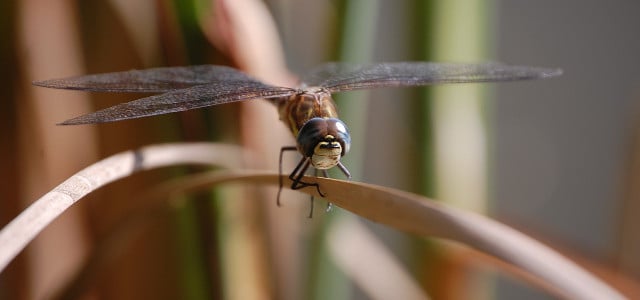Dragonflies are instantly recognizable, but how can you tell the different dragonfly types apart? We’ve put together a list of the most stunning bright colors, giant eyes, and long wings, as well as a few apps to help you identify them.
Dragonflies are some of the most bewitching types of insects in the world and are naturally fascinating to look at. These fascinating and ancient bugs have been keeping pests like mosquitoes at bay on every continent around the world for close to 300 million years.
Most species are tropical, so in the United States dragonflies are usually a sure sign that summer has finally arrived. Unforunatley, the world’s dragonfly populations are currently under threat due to the climate crisis which is causing a dangerous loss of wetlands and changes in their delicate habitats.
As both predators and prey, all types of dragonfly are essential in their ecosystems and play an important role in the healthy food chains of many animals. Because dragonflies rely heavily on aquatic ecosystems throughout their life, scientists refer to their populations as bioindicators of the overall health of an environment and water quality. They are also key to maintaining the balance of biodiversity in their habitats, which makes the conservation of this diverse species is all the more critical.
Are Any Types of Dragonflies Invasive?
Dragonflies are not currently considered an invasive species in the US. In fact, the dragonfly’s habitat is so delicately balanced that they are more at risk of other invasive species than becoming one themselves. The ecosystems in which each species inhabits are vulnerable to everything from pollution from humans to invasive trees and grasses.
Due to this delicate habitat, it can be just as difficult to cultivate a welcoming environment for the types of dragonfly you want to attract. Not to worry though, if that’s something you’re interested in we’ve put together a few tips for attracting dragonflies to your garden that should help you get on your way!
We’ve assembled a few of the most stunning dragonfly species, however, if you can’t find one you’ve seen on this list, we’ve also put together a list of apps that will help you identify our flighty friends.
1. Roseate Skimmer
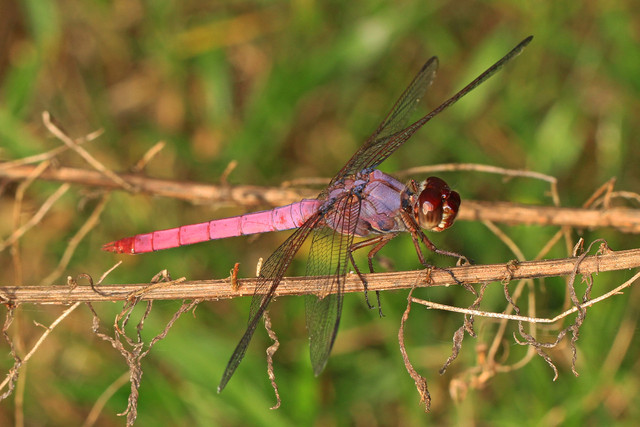
Orthemis ferruginea
Found across the Americas, the Roseate Skimmer is one of the gew lavender-colored dragonfly types seen in flight in the late summer or early fall. Thanks to its distinctive coloring and commonness, it’s hard to miss and perfect for anyone getting into dragonfly spotting!
This particular type of dragonfly prefers ponds and small pools for them to mate and lay eggs in, the more vegetation nearby and overhanging grasses for them to perch on, the better. This type of dragonfly is also a very aggressive predator, usually feeding on insects that are around the same size as it is.
2. Ebony Jewelwing
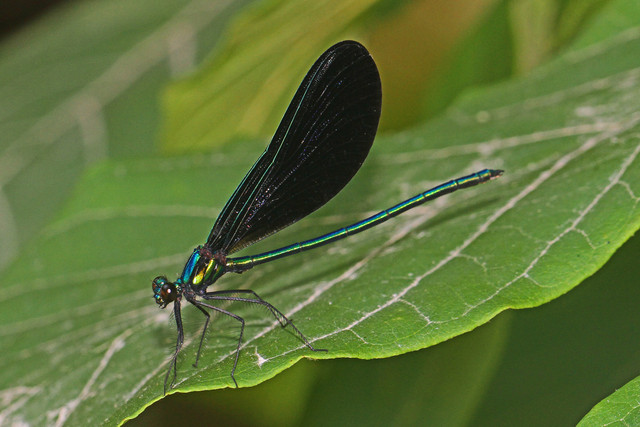


Calopteryx maculata
The Ebony Jewelwing actually a damselfly, a smaller type of dragonfly, with a slender, shiny blue-green body and matte black wings. Another common name for this stunning insect is Black-Winged Damselfly, due to its strikingly dark wings. Though they can be difficult to spot, if you do happen to see one in the wild, you won’t forget it in a hurry.
This species is found across eastern North America from May to July, ranging into the central and southern United States from March to October. Adult Ebony Jewelwings are not strong fliers, which means you can get close to them as long as you don’t make any sudden movements. They can be spotted most often lounging in patches of sunshine under a forest canopy near streams and small, slow-moving rivers, but they usually only stay a minute or two before flitting to another spot nearby.
3. Blue Dasher
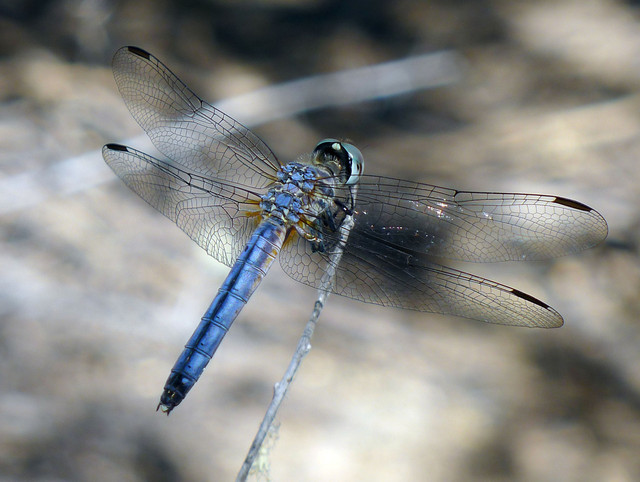


Pachydiplax longipennis
The Blue Dasher is a unique species within the genus Pachydiplax and a handsome, medium-sized dragonfly. Adults can be distinguished from other dragonfly types by paying close attention: For example, their forewings have distinguishing patterns only noticeable when observed at close range. More obvious features include their large eyes, which appear metallic in certain lighting, set onto a white face and the males’ blue abdomen with a black tip. The female has black stripes on her thorax, and her abdomen is shorter than her wings.
Adults are active from May to October and can be found in abundance around shallow, still waters across the Americas. They tend to perch right above the water on nearby vegetation, pointing their abdomens towards the sun with their wings angled downwards.
4. Green Darner
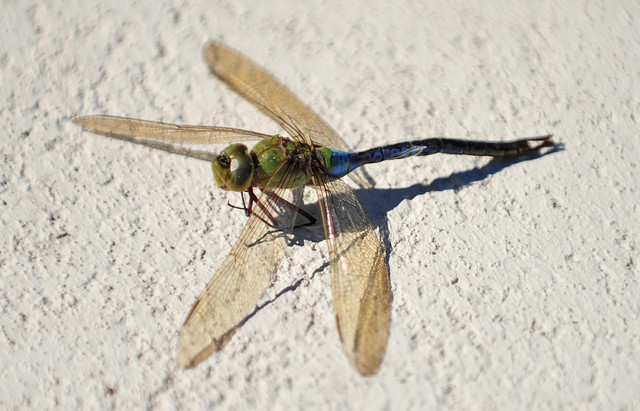


Anax junius
The Green Darner is a type of dragonfly whose name comes from its resemblance to a long darning-needle. It is one of the largest species of dragonfly in America, males reaching up to 3 inches in length with an almost equally wide wingspan. Surprisingly fast for its size and instantly recognizable by its dramatic green and blue coloring, it is one of the most common and abundant species in North America.
This strong-flying, migratory species, Green Darners are found in a variety of slow-flowing waters across the country at different times of the year. In general, spring migrants usually arrive from the south in early April, with new adults emerging in the late summer.
5. Ruby Meadowhawk
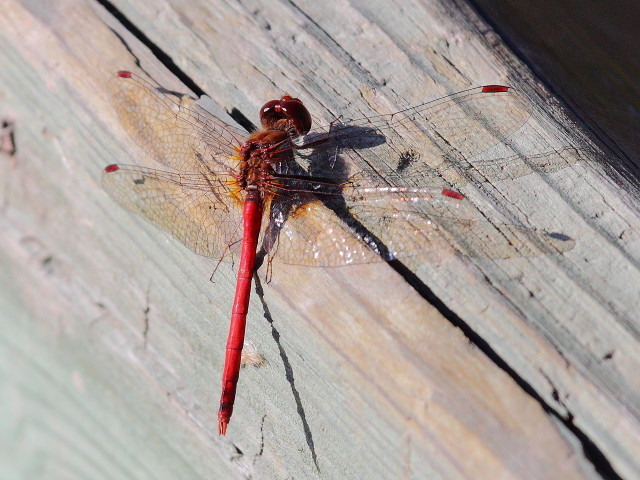


Sympetrum rubicundulum
The stunning deep red Ruby Meadowhawks are sometimes tricker to spot but worth the effort of tracking them down! Adult males can be identified by their orange-brown faces, red bodies and black spots on their abdomens. Female faces share the same colors as male faces, although their bodies are darker or mustard yellow.
They can be found in the northern United States and southern Ontario. Like most species of Sympetrum, the Ruby Meadowhawk is most often found near water in open fields. As the name suggests, males perch at the top of tall grasses or on shrubs and defend a small territory, much like a hawk in a meadow. They live in and around stagnant waters such as ponds or marshes.
6. Twelve Spotted Skimmer
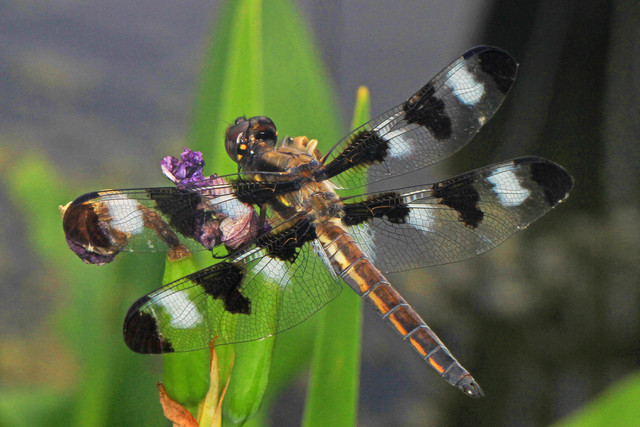


Libellula pulchella
The gorgeous stained-glass wings of the Twelve Spotted Skimmer are more than enough for this type of dragonfly to make it on our list. Both males and females of this species have three distinctive dark spots on each wing, ending in black at the wingtips, with adult males having additional chalky white spots between each of the dark spots.
One of the most common of the “skimmers”, this dragonfly type is found in many habitats across southern Canada and in all 48 of the contiguous US states. It is often the only skimmer found in the drying seasonal wetlands across North American. However, you can also find these fast flyers near the water’s edge of any body of still water throughout the summer.
Apps for Identifying Different Dragonfly Types
There are not many apps that can be used to identify dragonflies in the wild yet. However, the ones that are available happen to be of top quality and are perfect resources for beginners and professionals alike. Here we’ve complied a short list of some of the best apps you can use to help you identify different types of dragonflies.
Dragonfly ID
You can use the app to find places to look for dragonflies and learn more about the species. You can search by location, size, color, and habitat. It provides photographs, a sighting map, and a detailed description for most species, and you can add your discoveries to a list as you find new types of dragonfly.
Some users have reported issues with the formatting of the app, but it seems like the developers are consistently releasing updates and fixes, so this shouldn’t be too much of an issue.
Dragonfly ID Britain & Europe
If you’re on vacation across the pond, there’s also a field guide to the dragonflies and damselflies of Britain, Ireland, and Europe. Simply select your country and begin identifying dragonflies!
Native dragonflies and damselflies can be difficult to identify when you’re away from home. This app is aimed at both beginners and professionals and includes automatic photo recognition, which should help you get more accurate results.
Google Lens
In a pinch, you can always try out Google Lens for identification of a dragonfly spotted in the wild. Android users can download the app directly, however apple users will have to go through the Google app and use the image search function. Although not always 100 percent accurate, Google Lens is a great tool to point you in the right direction for dragonfly identification.
r/Dragonflies
Finally, if all else fails you, there is no better recourse than other enthusiasts like you. Join the dragonfly community on Reddit and ask the other members if they can help you identify your findings. Remember to be kind and respectful to others online!
Read more:
- Picnic Date Ideas: Romantic Dining for Two
- What Does “Endangered” Mean? A Closer Look
- 5 Free Insect Identification Apps to Try
Do you like this post?






